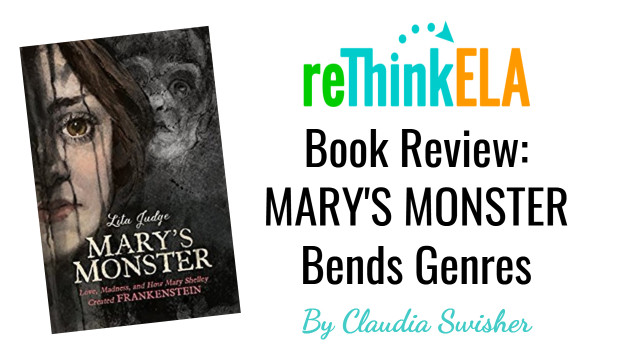Just as Mary Wollstonecraft Shelley invented the modern “mad scientist,’ so does Lita Judge invent a new genre to tell Mary’s story…a graphic biography in verse. Judge creates the words and the black-and-white watercolor illustrations of Mary and the people who influenced her life and art…and always the Creature is there, suggested by a slashing line to represent a scar, or the sad failings of parents, or lovers and friends who desert her.
Mary was born as her mother died, and was raised by her father, William Godwin, once a fiery revolutionary, along with Mary Wollstonecraft. They lived outside of conventions, but middle age found William a sad, hen-pecked shopkeeper, unable to answer the same fire in his daughter’s eyes.
Mary’s tale is told in nine Parts, to reflect the nine months she took to ‘birth’ the Creature’s tale, and the nine months she carried her four children, only one of whom grew to adulthood. Nine months.
Parenthood — its dangers and its failings and its beauty and its responsibility — are underlying themes of Mary’s life, and Mary’s story. Her guilt over her own mother’s death, the loss of her own babies, the shortcomings of Percy’s and Byron’s care of their little ones, all bring a tragedy to the novel she creates. She doesn’t flinch in her depiction of a man who creates life but betrays his Creature in time of need.
Much of this tale is not new. Mary, Shelley, mad, bad, Byron, and Byron’s personal physician spend the summer together in 1816, the year without summer because of a volcano eruption…Their unconventional life, their quest for perfect freedom and perfect artistic expression are all there on the pages. In this rarified summer, Mary creates a story, a character, that outlives her by nearly 200 years.
Judge takes the details we know, and with her research, adds new details, weaving them into the narrative of a young woman who wanted to live and love. A woman who was haunted by her sense of responsibility in her own mother’s death. Deaths of too many people she loved. And finally the drowning death of her beloved Shelley.
The watercolor illustrations are mesmerizing…haunting. No color in Mary’s life, or in the Creature’s existence. Just black and white and greys. The creature haunts this book. Mary’s life begins in death, and death seems to follow her. It repeatedly takes those she loved. But she keeps walking forward in that darkness. She finds a two-fold purpose: to ceaselessly promote Shelley’s genius, and to revise and refine her own masterpiece.
The narrative is mostly in Mary’s voice, but, fittingly, the Creature has the first words and the last words: “It is I who keep her faith alive.”
This book would make a splendid addition to the English 4 classroom, as a way to make Mary and Shelley and Byron breathe…these stuffy ‘classics’ whose passions are easy to dismiss are vibrant and messily-human here. But they are alive and interesting. I would love to use this book to introduce a unit studying the Romantics, and Mary’s masterpiece: Frankenstein.
[bctt tweet=”Use Mary’s Monster to introduce a unit studying the Romantics, and Mary’s masterpiece: Frankenstein. #litchat”]
Because I am a book nerd, I read everything between the covers of books: introduction, afterwords, acknowledgements. Again, this book does not disappoint…notes about her process, notes about the major characters, background that doesn’t make it into the book. Extensive notes for each Part, and a Bibliography are included, as is a reading list of books from Mary’s journal. This book has the weight of deep research behind every word.
AND, there are acknowledgements to other YAL novelists: Karen Hesse, author of Out of The Dust, was an early reader. Meg Kearney, author of When You Never Say Goodbye, and Kristin Cashore, author of the Graceling Realm series, are thanked. I love seeing the connections among authors, and then I try to see connections among their work.
So, Lita Judge has created a new kind of book, just as Mary did. She lovingly brings Shelley and her world to life. She creates illustrations that are breathtaking and evocative. She does credit to Mary’s masterpiece, on this, the 200th anniversary of the year of its publication. Now I want to reread Frankenstein with new eyes.

